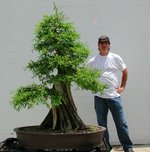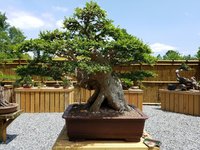Clicio
Masterpiece
I've been watching the way - apparently fashionable - that people doing bonsai get all enthusiastic about big trunks with no branches, no radial roots, no interesting deadwood but...
Large.
Heavy.
Thick.
Some are literally ground trees freshly dug out from the ground, chopped down, and sold immediately.
Of course a big, impressive trunk, can be part of a good bonsai; what I question here is: what about the elegant, the tall, the flared, the literati, the forests, the small delicate flowering bonsai in a beautiful pot?
Nope. Not impressive enough.
I am talking about most new enthusiasts on the Internet groups.
For them, bigger is always better.
Large.
Heavy.
Thick.
Some are literally ground trees freshly dug out from the ground, chopped down, and sold immediately.
Of course a big, impressive trunk, can be part of a good bonsai; what I question here is: what about the elegant, the tall, the flared, the literati, the forests, the small delicate flowering bonsai in a beautiful pot?
Nope. Not impressive enough.
I am talking about most new enthusiasts on the Internet groups.
For them, bigger is always better.


